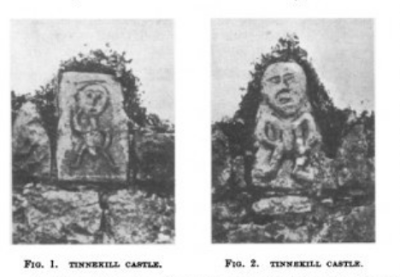Tinnakill Castle
First and foremost my gratitude is due to the landowner who farms here for his permission to enter and photograph this Laois Tower House.
Without his help this post would have little to no photographic record of this wonderful local antiquity which is steeped in history.
The Castle is located in a rural area somewhat midway between Mountmellick and Portarlington.
From what I have gathered online the Castle was once called Tynekill Castle. It is an Irish Tower House and is believed to date between the late 16th or early 17th century.
Having been granted to the MacDonnells circa. 1562 we can assume it had previous inhabitants who were dispossessed so presumably it's quite likely the Castle dates to a period slightly earlier than that mentioned online.
There was purportedly a Sheela na Gig removed from the Castle and inserted into a garden wall alongside another, possibly taken from nearby Portnahinch Church ruins.
When enquiries were made in an effort to locate them they were both reported as destroyed with the fragments used as building material.
A fishy sounding story if ever there were one and quite likely nothing but Codswallop.
We will never know exactly what happened to these valuable artifacts but with less than 130 examples in the Country their loss is both unquantifiable and immeasurable.
Tinnakill was for most of its working life a MacDonnell Castle.
The MacDonnells were Scottish "planters" who settled in this area.
The Laois/Offaly plantation of the mid 1500's which began under Queen Mary was just one of a number of attempts to remove both the native population and "unfaithful" early settlers from the land and replace them with "planters", chiefly English, Scottish and Welsh.
The "planters" were granted lands and titles by the English Monarch in order to subdue and control Ireland and reap the subsequent economic rewards.
The plantation of Laois/Offaly proved to be a particularly successful endeavor.
Laois became Queen's County, named after Queen Mary I, with Maryborough, now Portlaoise, as its County seat.
Offaly became King's County and was named such after Mary's husband, the King of Spain, King Philip II.
Philipstown, now Daingan, was its County seat.
It was strange times indeed when an Irish midlands town could logically be named after a Spanish King.
The MacDonnells were granted the right to the Castle on the understanding that they maintained a number of Gallowglass soldiers (9 to 12) ready for use by the Crown forces should they be requested and if requested they be "victualled" for three days.
I have lost my original source of reference but in a twist of faith and within a generation a subsequent head of the MacDonnell Clan at Tinnakill was no longer a trusted servant of the Crown but rather a renegade with a bounty placed on his head.
How quick indeed the winds of change do blow.
The Tinnakill Duanaire is an early 17th century manuscript containing 83 "bardic religious poems" and is unusual for its type in being chiefly written on Sheepskin parchment.
It was owned by the MacDonnells and in now housed in Trinity College Dublin. I have listed a link to the full manuscript at dias.ie online below.
Further Reading:
.jpg)
.jpg)
.jpg)
.jpg)

.jpg)
.jpg)
.jpg)
.jpg)
.jpg)
.jpg)
.jpg)


